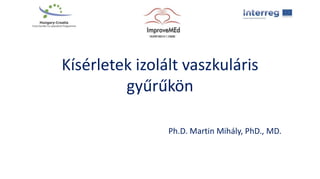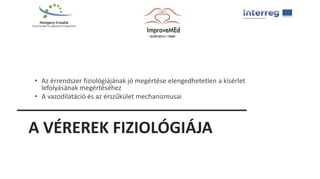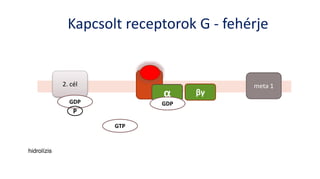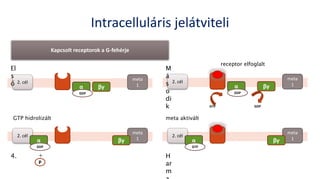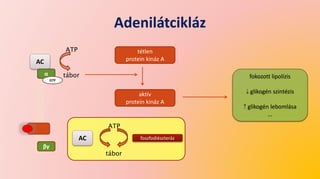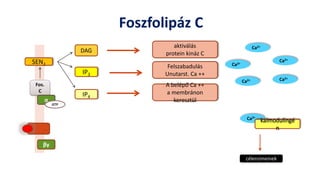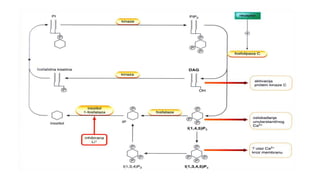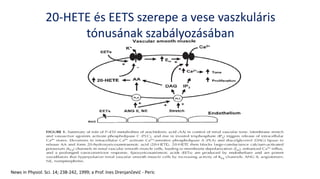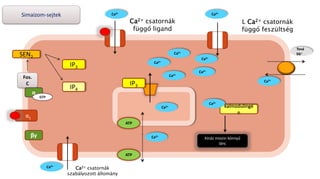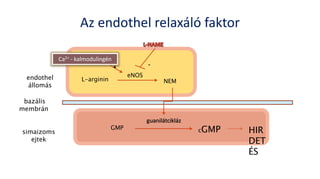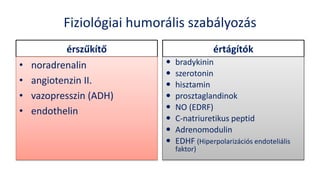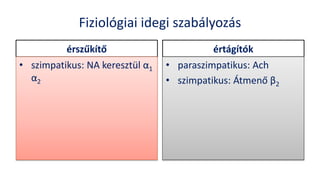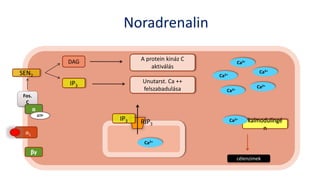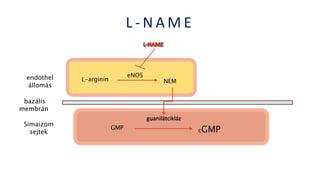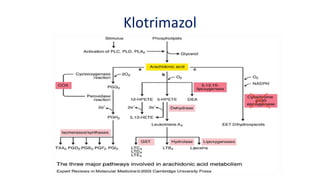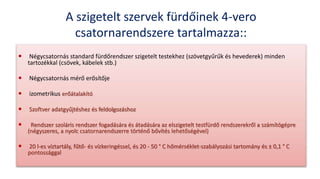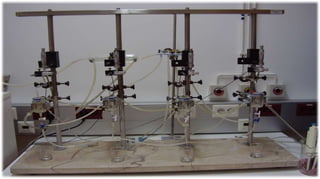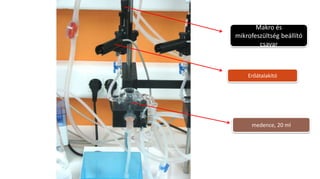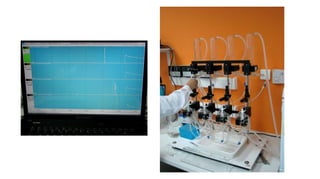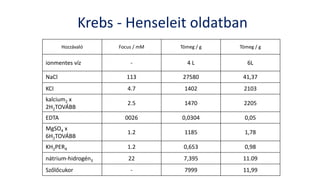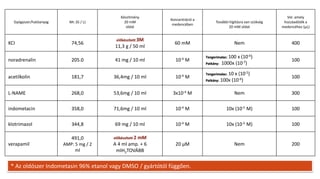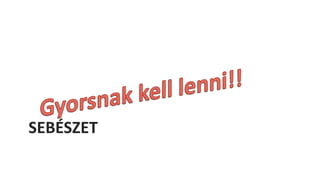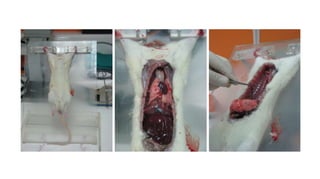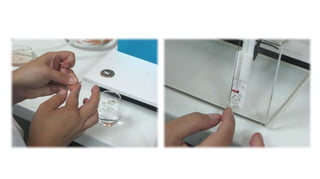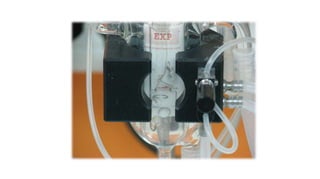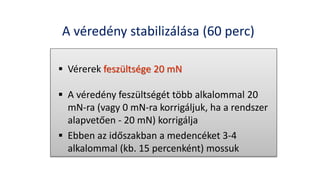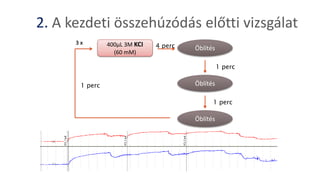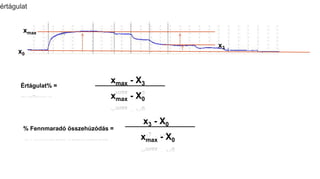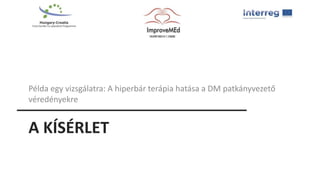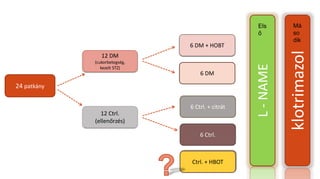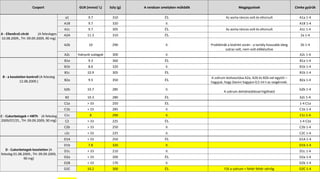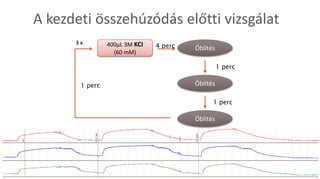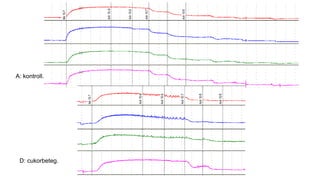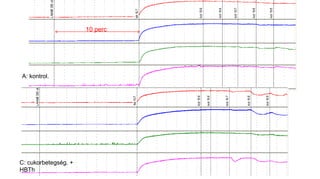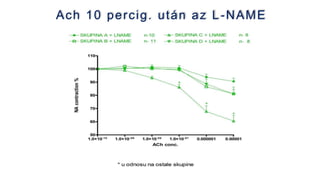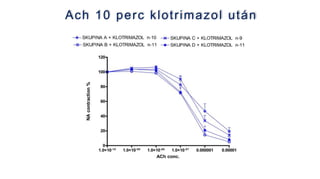KÃsÃĐrletek izolÃĄlt vaszkulÃĄris gyÅąrÅąkÃķn
- 1. KÃsÃĐrletek izolÃĄlt vaszkulÃĄris gyÅąrÅąkÃķn Ph.D. Martin MihÃĄly, PhD., MD.
- 2. A VÃREREK FIZIOLÃGIÃJA âĒ Az ÃĐrrendszer fiziolÃģgiÃĄjÃĄnak jÃģ megÃĐrtÃĐse elengedhetetlen a kÃsÃĐrlet lefolyÃĄsÃĄnak megÃĐrtÃĐsÃĐhez âĒ A vazodilatÃĄciÃģ ÃĐs az ÃĐrszÅąkÞlet mechanizmusai
- 3. IntracellulÃĄris jelÃĄtvitel A receptorok tÃpusai: 1. ReceptorfÞggÅ ioncsatornÃĄk (ionotrÃģp ÃĐs receptor receptorok) 2. G-fehÃĐrjÃĐvel (metabotrÃģp receptorokkal) Ãķsszekapcsolt receptorok 3. KinÃĄz receptorok 4. NukleÃĄris receptorok
- 4. R R E R à R à R CellulÃĄris vÃĄlasz CellulÃĄris vÃĄlasz CellulÃĄris vÃĄlasz CellulÃĄris vÃĄlasz hiperpolarizÃĄciÃģt vagy depolarizÃĄciÃģ Az ingerlÃĐkenys ÃĐg vÃĄltozÃĄsa mÃĄs hÃrvivÅk mentesÃtÃĐsi Ca2+ a proteinek foszforilezÃĐsÃĐn ek mÃĄs a proteinek foszforilezÃĐsÃĐn ek transzkripciÃģs gÃĐnek protein szintÃĐzis R transzkripciÃģs gÃĐnek protein szintÃĐzis ElsÅ receptor- fÞggÅ ioncsatornÃĄk MÃĄsodik kapcsolt receptorok a G- fehÃĐrjÃĐk (A metabotrop receptorok) 3. kinÃĄz receptorok 4. nukleÃĄris receptor IdÅvonal: ms PÃĐlda: dohÃĄnyos ACh receptor IdÅvonal: ÃģrÃĄk PÃĐlda: citokin receptor IdÅvonal: ÃģrÃĄk PÃĐlda: ÃķsztrogÃĐn receptorok IdÅvonal: mÃĄsodperc PÃĐlda: Muszkarin acetil-kolin-receptor
- 5. meta 12. cÃĐl Îą GDP meta 1 GTP ÎēÎģ GDP P hidrolÃzis Kapcsolt receptorok G - fehÃĐrje
- 6. IntracellulÃĄris jelÃĄtviteli Kapcsolt receptorok a G-fehÃĐrje meta 1 2. cÃĐl Îą ÎēÎģ GDP meta 1 2. cÃĐl Îą ÎēÎģ GDP GTP meta 1 2. cÃĐl Îą ÎēÎģ GTP meta 1 2. cÃĐl Îą ÎēÎģ GDP + P receptor elfoglalt meta aktivÃĄltGTP hidrolizÃĄlt El s Å 4. H ar m M ÃĄ s o di k GDP
- 8. AdenilÃĄtciklÃĄz AC Îą ÎēÎģ GTP ATP tÃĄbor tÃĐtlen protein kinÃĄz A aktÃv protein kinÃĄz A foszfodiÃĐszterÃĄz ATP tÃĄbor AC fokozott lipolÃzis âĢ glikogÃĐn szintÃĐzis ⥠glikogÃĐn lebomlÃĄsa ...
- 9. Ca2+ FoszfolipÃĄz C Fos. C Îą ÎēÎģ GTP SEN2 DAG IP3 IP4 aktivÃĄlÃĄs protein kinÃĄz C FelszabadulÃĄs Unutarst. Ca ++ A belÃĐpÅ Ca ++ a membrÃĄnon keresztÞl kalmodulingÃĐ n cÃĐlenzimeinek Ca2+ Ca2+ Ca2+ Ca2+ Ca2+
- 12. News in Physiol. Sci. 14; 238-242, 1999; a Prof. Ines DrenjanÄeviÄ - Peric 20-HETE ÃĐs EETS szerepe a vese vaszkulÃĄris tÃģnusÃĄnak szabÃĄlyozÃĄsÃĄban
- 13. Îą1 Fos. C Îą ÎēÎģ GTP SEN2 IP3 IP4 Ca2+ Ca2+ Ca2+ Ca2+ Ca2+ kalmodulingÃĐ n KinÃĄz miozin kÃķnnyÅą lÃĄnc IP3 Simaizom-sejtek L Ca2+ csatornÃĄk fÞggÅ feszÞltsÃĐg Ca2+ csatornÃĄk fÞggÅ ligand ATP ATP Ca2+ csatornÃĄk szabÃĄlyozott ÃĄllomÃĄny Ca2+ Ca2+ Ca2+ Ca2+ Ca2+ Ca2+ Ca2+ TovÃĄ bb+
- 15. L-arginin NEM eNOS GMP guanilÃĄtciklÃĄz cGMP endothel ÃĄllomÃĄs simaizoms ejtek bazÃĄlis membrÃĄn HIR DET ÃS Az endothel relaxÃĄlÃģ faktor Ca2+ - kalmodulingÃĐn + -
- 16. FiziolÃģgiai humorÃĄlis szabÃĄlyozÃĄs ÃĐrszÅąkÃtÅ âĒ noradrenalin âĒ angiotenzin II. âĒ vazopresszin (ADH) âĒ endothelin ÃĐrtÃĄgÃtÃģk ï bradykinin ï szerotonin ï hisztamin ï prosztaglandinok ï NO (EDRF) ï C-natriuretikus peptid ï Adrenomodulin ï EDHF (HiperpolarizÃĄciÃģs endoteliÃĄlis faktor)
- 17. FiziolÃģgiai idegi szabÃĄlyozÃĄs ÃĐrszÅąkÃtÅ âĒ szimpatikus: NA keresztÞl Îą1 Îą2 ÃĐrtÃĄgÃtÃģk âĒ paraszimpatikus: Ach âĒ szimpatikus: ÃtmenÅ Îē2
- 18. VAZOAKTÃV GYÃGYSZEREK HATÃSAI AZ EREKRE âĒ acetilkolin âĒ L-NAME âĒ indometacin âĒ KOTRIMAZOL âĒ verapamil âĒ NO-donorok âĒ KCI âĒ noradrenalin
- 19. Noradrenalin Îą1 Fos. C Îą ÎēÎģ GTP SEN2 DAG IP3 A protein kinÃĄz C aktivÃĄlÃĄs Unutarst. Ca ++ felszabadulÃĄsa Ca2+ Ca2+ Ca2+ Ca2+ Ca2+ kalmodulingÃĐ n cÃĐlenzimek IP3 RIP3 Ca2+ Ca2+
- 21. L - N A M E L-arginin NEM eNOS GMP guanilÃĄtciklÃĄz cGMP endothel ÃĄllomÃĄs Simaizom sejtek bazÃĄlis membrÃĄn
- 22. Indometacin arachidonsav sav OFJ2 COX AMP adenilÃĄtciklÃĄz cAMP endothel ÃĄllomÃĄs simaizomsejt ek - OFJ2 (Prosztaciklin) szerepe az endothelium-fÞggÅ ÃĐrtÃĄgulÃĄsban viszonylag kicsi bazÃĄlis membrÃĄn
- 23. Klotrimazol
- 25. A VIZSGÃLAT ELÅKÃSZÃTÃSE âĒ IndÃtÃģ rendszer (37 ° C hÅmÃĐrsÃĐklet, O2 szÃĄllÃtÃĄsa stb.) âĒ A rendszer kalibrÃĄlÃĄsa âĒ Krebs Henseleit oldat elkÃĐszÃtÃĐse âĒ GyÃģgyszeres terÃĄpia
- 26. A szigetelt szervek fÞrdÅinek 4-vero csatornarendszere tartalmazza:: ï NÃĐgycsatornÃĄs standard fÞrdÅrendszer szigetelt testekhez (szÃķvetgyÅąrÅąk ÃĐs hevederek) minden tartozÃĐkkal (csÃķvek, kÃĄbelek stb.) ï NÃĐgycsatornÃĄs mÃĐrÅ erÅsÃtÅje ï izometrikus erÅÃĄtalakÃtÃģ ï Szoftver adatgyÅąjtÃĐshez ÃĐs feldolgozÃĄshoz ï Rendszer szolÃĄris rendszer fogadÃĄsÃĄra ÃĐs ÃĄtadÃĄsÃĄra az elszigetelt testfÞrdÅ rendszerekrÅl a szÃĄmÃtÃģgÃĐpre (nÃĐgyszeres, a nyolc csatornarendszerre tÃķrtÃĐnÅ bÅvÃtÃĐs lehetÅsÃĐgÃĐvel) ï 20 l-es vÃztartÃĄly, fÅątÅ- ÃĐs vÃzkeringÃĐssel, ÃĐs 20 - 50 ° C hÅmÃĐrsÃĐklet-szabÃĄlyozÃĄsi tartomÃĄny ÃĐs Âą 0,1 ° C pontossÃĄggal
- 28. ErÅÃĄtalakÃtÃģ medence, 20 ml Makro ÃĐs mikrofeszÞltsÃĐg beÃĄllÃtÃģ csavar
- 30. HozzÃĄvalÃģ Focus / mM TÃķmeg / g TÃķmeg / g ionmentes vÃz - 4 L 6L NaCl 113 27580 41,37 KCI 4.7 1402 2103 kalcium2 x 2H2TOVÃBB 2.5 1470 2205 EDTA 0026 0,0304 0,05 MgSO4 x 6H2TOVÃBB 1.2 1185 1,78 KH2PER4 1.2 0,653 0,98 nÃĄtrium-hidrogÃĐn3 22 7,395 11.09 SzÅlÅcukor - 7999 11,99 Krebs - Henseleit oldatban
- 31. GYÃGYSZEREK ELÅKÃSZÃTÃSE A VIZSGÃLATHOZ âĒ A gyÃģgyszereket 20 mM (kivÃĐtelesen 3M ÃĐs 2 mM) mennyisÃĐgben kÃĐszÃtjÞk el. âĒ 2â3 hÃģnapig tÃĄroljuk -20 ° C-on âĒ KCI
- 32. GyÃģgyszer/hatÃģanyag Mr. (G / L) KÃĐszÃtmÃĐny 20 mM oldat KoncentrÃĄciÃģ a medencÃĐben TovÃĄbbi hÃgÃtÃĄsra van szÞksÃĐg 20 mM oldat Vol. amely hozzÃĄadÃģdik a medencÃĐhez (ΞL) KCI 74,56 elÅkÃĐszÃtett 3M 11,3 g / 50 ml 60 mM Nem 400 noradrenalin 205.0 41 mg / 10 ml 10-4 M Tengerimalac: 100 x (10-6) PatkÃĄny: 1000x (10-7) 100 acetilkolin 181,7 36,4mg / 10 ml 10-4 M Tengerimalac: 10 x (10-5) PatkÃĄny: 100x (10-6) 100 L-NAME 268,0 53,6mg / 10 ml 3x10-4 M Nem 300 indometacin 358,0 71,6mg / 10 ml 10-4 M 10x (10-5 M) 100 klotrimazol 344,8 69 mg / 10 ml 10-4 M 10x (10-5 M) 100 verapamil 491,0 AMP: 5 mg / 2 ml elÅkÃĐszÃtett 2 mM A 4 ml amp. + 6 mlH2TOVÃBB 20 ΞM Nem 200 * Az oldÃģszer Indometasin 96% etanol vagy DMSO / gyÃĄrtÃģtÃģl fÞggÅen.
- 33. ģ§·ĄĩþÃģ§īÜ·Ą°Õ
- 37. SZABVÃNYOS PROTOKOLL 1. A vÃĐredÃĐnyek stabilizÃĄlÃĄsa 2. A kezdeti ÃķsszehÚzÃģdÃĄs elÅtti vizsgÃĄlat 3. Endothelialis intaktitÃĄsvizsgÃĄlat 4. VaszkulÃĄris aktivÃĄciÃģs teszt
- 38. A vÃĐredÃĐny stabilizÃĄlÃĄsa (60 perc) ï§ VÃĐrerek feszÞltsÃĐge 20 mN ï§ A vÃĐredÃĐny feszÞltsÃĐgÃĐt tÃķbb alkalommal 20 mN-ra (vagy 0 mN-ra korrigÃĄljuk, ha a rendszer alapvetÅen - 20 mN) korrigÃĄlja ï§ Ebben az idÅszakban a medencÃĐket 3-4 alkalommal (kb. 15 percenkÃĐnt) mossuk
- 39. 2. A kezdeti ÃķsszehÚzÃģdÃĄs elÅtti vizsgÃĄlat 400ΞL 3M KCI (60 mM) ÃblÃtÃĐs ÃblÃtÃĐs ÃblÃtÃĐs 4 perc 1 perc 1 perc 1 perc 3 x
- 40. 3. Endothelialis intaktitÃĄsvizsgÃĄlat 100ΞL 1000x osztÃĄly. 20 mM noradrenalin (10-7M) 100ΞL 100x Class. 20 mM acetilkolin (10-6M) ÃblÃtÃĐs4 min 1 perc 1 perc ÃblÃtÃĐs ÃblÃtÃĐs 4 min
- 41. 4. VaszkulÃĄris aktivÃĄciÃģs teszt 100ΞL 1000x osztÃĄly. 20 mM noradrenalin (10-7M) ÃĐrtÃĄgÃtÃģ kÞlÃķnbÃķzÅ dÃģzisokban 4 min
- 43. ADATFELDOLGOZÃS A vasodilatÃĄciÃģ% -ÃĄnak kiszÃĄmÃtÃĄsÃĄhoz hasznÃĄlt kÃĐplet ..
- 44. x0 xmax x3 ÃrtÃĄgulat% = xmax - X3 xmax - X0 % FennmaradÃģ ÃķsszehÚzÃģdÃĄs = x3 - X0 xmax - X0 ÃĐrtÃĄgulat
- 45. A KÃSÃRLET PÃĐlda egy vizsgÃĄlatra: A hiperbÃĄr terÃĄpia hatÃĄsa a DM patkÃĄnyvezetÅ vÃĐredÃĐnyekre
- 46. 24 patkÃĄny 12 Ctrl. (ellenÅrzÃĐs) 12 DM (cukorbetegsÃĐg, kezelt STZ) 6 Ctrl. 6 Ctrl. + citrÃĄt 6 DM 6 DM + HOBT L-NAME klotrimazol Els Å MÃĄ so dik Ctrl. + HBOT
- 47. Csoport GUK (mmol/ L) SÚly (g) A rendszer amelyben mÅąkÃķdik MegjegyzÃĐsek CÃmke gyÅąrÅąk A - EllenÅrzÅ citrÃĄt (A felesleges 10.08.2009., TH: 09.09.2009, 90 mg) a1 9.7 310 ÃS. Az aorta rÃĄncos volt ÃĐs eltorzult A1a 1-4 A1B 9.7 320 II. A1B 1-4 A1c 9.7 305 ÃS. Az aorta rÃĄncos volt ÃĐs eltorzult A1c 1-4 A2A 11.3 310 ÃS. 2a 1-4 A2b 10 290 II. ProblÃĐmÃĄk a kÃsÃĐrlet sorÃĄn - a tartÃĄly hosszabb ideig szÃĄraz volt, nem volt elÅkÃĐszÃtve 2b 1-4 A2c hiÃĄnyzik szalagok 300 II. A2c 1-4 B - a kezeletlen kontroll (A felesleg 12.08.2009.) B1a 9.3 360 ÃS. B1a 1-4 B1b 8.6 320 II. B1b 1-4 B1c 10.9 305 ÃS. B1b 1-4 B2a 9.5 350 ÃS. A szÃĐrum leolvasztÃĄsa A2a, A2b ÃĐs B2b-vel egyÞtt â hagyjuk, hogy Danini hagyjon 0,5 ml-t az oxigÃĐnnek. B2a 1-4 b2b 10.7 285 II. A szÃĐrum dehidratÃĄlÃĄssal hÃgÃthatÃģ b2b 1-4 B2 10.3 280 ÃS. b2c 1-4 C - Cukorbetegek + HBTh (A felesleg 2009/07/25., TH: 09.09.2009, 90 mg) C1a > 33 250 ÃS. 1-4 C1a C1b > 33 285 II. C1b 1-4 C1c 8 290 II. C1c 1-4 C2 > 33 225 ÃS. 1-4 C2a C2b > 33 250 II. C2b 1-4 c2c > 33 225 II. C2C 1-4 D - Cukorbetegek kezeletlen (A felesleg 01.08.2009., TH: 09.09.2009, 90 mg) D1A > 33 250 ÃS. D1A 1-4 D1b 7.8 320 II. D1b 1-4 D1c > 33 210 II. D1c 1-4 D2a > 33 200 ÃS. D2a 1-4 D2B > 33 170 II. D2b 1-4 D2C 10.2 300 ÃS. FÅąt a szÃĐrum + fehÃĐr fehÃĐr vÃĐrrÃķg D2C 1-4
- 48. A kezdeti ÃķsszehÚzÃģdÃĄs elÅtti vizsgÃĄlat 400ΞL 3M KCI (60 mM) ÃblÃtÃĐs ÃblÃtÃĐs ÃblÃtÃĐs 4 perc 1 perc 1 perc 1 perc 3 x
- 50. A: kontrol. C: cukorbetegsÃĐg. + HBTh 10 perc
- 51. A: kontrol. C: cukorbetegsÃĐg. + HBTh
- 53. Ach 10 percig. utÃĄn az L-NAME
- 54. Ach 10 perc klotrimazol utÃĄn
